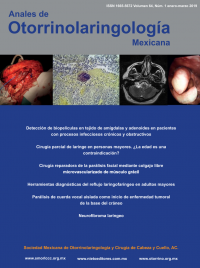Detection of biofilms in tonsil and adenoid tissue in patients with chronic and obstructive infectious processes.

An Orl Mex. 2019 enero-marzo;64(1):1-7.
Nadia B Villanueva-Ramos,1 Alma R De la Mora-Fernández,2 Efrén R Ríos-Burgueño,3 Felipe de J Peraza-Garay4
1 Residente de cuarto año de Otorrinolaringología.
2 Jefe y médico adscrito al Servicio de Otorrinolaringología.
3 Jefe y médico adscrito al Servicio de Anatomía Patológica.
Hospital Civil de Culiacán, Culiacán, Sinaloa.
4 Doctor en Estadística. Asesor estadístico y metodológico, Centro de Investigación y Docencia en Ciencias de la Salud (CIDOCS), Culiacán, Sinaloa.
Resumen
ANTECEDENTES: Una de las afecciones otorrinolaringológicas más frecuentes es la relacionada con amígdalas y adenoides. La resistencia a antibióticos y cronicidad de esta enfermedad pueden deberse a comunidades estructuradas de bacterias adheridas a la superficie epitelial, conocidas como películas.
OBJETIVO: Analizar la existencia de biopelículas en tejido adenoamigdalino de pacientes con cuadros infecciosos o con cuadros obstructivos.
MATERIAL Y MÉTODO: Estudio descriptivo, observacional, transversal y prospectivo, en el que se analizó tejido obtenido de cirugías de pacientes con hipertrofia adenoamigdalina, amigdalitis crónica o ambas, de agosto de 2014 a noviembre de 2016; se determinó la existencia de biopelículas por histopatología y variables demográficas.
RESULTADOS: Se incluyeron 138 muestras de 73 pacientes (52.9%) masculinos y 65 (47.1%) mujeres, con edad media de 13.8 años (intervalo: 2-62 años). Las biopelículas se encontraron en 43.7% de los pacientes. Se relacionó la detección de biopelículas en cada proceso patológico, no se encontró diferencia estadísticamente significativa. Se demostró la existencia de biopelículas en 96 muestras (69.6%) usando microscopia de luz, de éstos, 65 pacientes (72.2%) fueron de padecimiento infeccioso y 31 pacientes (64.6%) de enfermedad obstructiva (p = 0.438). No hubo diferencia significativa entre la existencia de biopelículas asociada con proceso adenoamigdalino infeccioso u obstructivo.
CONCLUSIONES: Se demostró la existencia de biopelículas en 69.6% usando microscopia de luz y tres tinciones.
PALABRAS CLAVE: Amígdala palatina; amígdala faríngea; biopelículas; amigdalitis.
Abstract
BACKGROUND: One of the most frequent otorhinolaryngological conditions is related to tonsils and adenoids. The resistance to antibiotics and chronicity that this disease presents may be due to the presence of structured communities of bacteria adhered to the epithelial surface, known as biofilms.
OBJECTIVE: To analyze the presence of biofilms in adenotonsillar tissue of patients with infectious diseases or with obstructive symptoms.
MATERIAL AND METHOD: A descriptive, observational, cross-sectional and prospective study was done in which tissue obtained postoperatively in patients with adenotonsillar hypertrophy and/or chronic tonsillitis was included within the period from August 2014 to November 2016; the presence of biofilms was determined by histopathology; demographic variables were also reported.
RESULTS: 138 samples were included, 73 patients (52.9%) were men and 65 women (47.1%) with an average age of 13.8 years (range: 2-62 years). The biofilms were found in 69.6% of the patients, of these, 65 (72.2%) were of infectious pathology and 31 (64.6%) of obstructive disease (p = 0.438). Relating the detection of biofilms in each pathological process, no statistically significant difference was found. The presence of biofilms was demonstrated in 96 (69.6%) using light microscopy. There was no significant difference between the presence of biofilms associated with adenoamigdaline infection or obstructive process.
CONCLUSIONS: The presence of biofilms was demonstrated in 69.6% using light microscopy and three stains.
KEYWORDS: Palatine tonsil; Pharyngeal tonsil; Biofilms; Tonsillitis.

